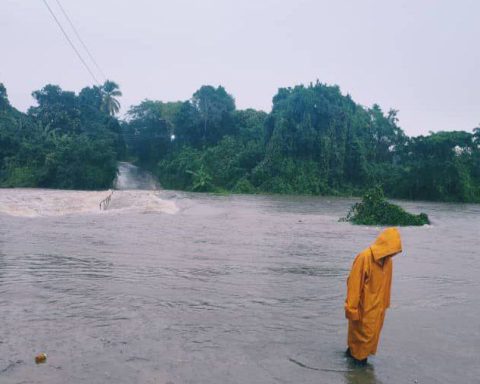Uruguay needs the rain to reverse the few fresh water reserves remaining for Montevideo and the metropolitan area. Although in the Executive and in SBI bet on abundant water falling in the last days of May, the government added measures to, in some cases, ensure water supply with sodium levels and current chloride and, in others, for deliver better quality water.
As for the rainythe amount of water that fell in the first 23 days of May did not reverse the water deficit in the Santa Lucía basin. The average rainfall was 16 millimeters in those 23 days.
This Wednesday the 24th, until 4:00 p.m., between 5 and 10 millimeters had fallen on the Paso Severino dam and the Aguas Corrientes dam, according to Inumet data.
The rains will continue on Thursday and Friday and will reach an average of between 20 and 50 millimeters accumulated. But then a new “dry period” will begin until at least June 7.
The government and OSE are therefore betting on maintaining the situation through works and desalination plants. What does each solution imply?
The immediate bet: the new dam in Paso Belastiquí
This Saturday a company contracted by SBI started building a precarious dam –or dike– on the Santa Lucía river at the height of Paso Belastiquí, on the border between San José and Canelones.
Less than a week later, this Tuesday, the state company began to use the place to retain water from the Río de la Plata. The solution emergency is essential according to the state, to maintain the current water quality – that is, with exceptional sodium and chloride levels.
The work is a embankment so that OSE can retain water from the Río de la Plata when there is low tide and so prevent water from returning to the riverwhich will improve the availability in Running waters.
With this emergency work, OSE seeks to maintain the mix of fresh water and salt water. “With the construction of this dam, it is possible to ensure a raw water reserve of approximately one million cubic meters”, considered the board of OSE when it approved the work. That million cubic meters is mixed, in turn, with fresh water from Paso Severino or the Santa Lucia River.
He OSE president, Raúl Monteroexplained to The Observer that pumping downstream of the Río de la Plata –which is saltier water– depends on the high tide. If it is not, as has been the case in the last few days, it should be take more freshwater reserves of Paso Severino –which are in just about four million cubic meters– in order to ensure the amount of water consumed per day in Montevideo and the metropolitan area. “The dam assures us that we can continue with the same pumping rate we have now,” said the chief.
In other words, the new dam in Paso Belastiquí ensures that one million cubic meters of salt water can be transferred to Aguas Corrientes to continue mixing it with fresh water from Severino Pass and the Santa Lucia Riveras it happens now.
The UTE desalination plant
UTE has a thermal plant in the plant of Tiger Point that it is inoperative, because the company is using the Salto Grande dam.
In Punta del Tigre, UTE has a desalination plant that “was not designed to make water drinkable,” said Montero. However, OSE analyzes using it to remove sodium from water, although the amount that will be obtainedor it will be able to supply all the daily consumption.
The UTE desalination plant can remove sodium from 300 cubic meters of water per hour, that is, about 7,200 cubic meters per day. This is just a 1.3% of the total water consumption of Montevideo and the metropolitan area in one day.
The water obtained from this desalination plant -which also requires other chemical processes because it comes out with such low levels of sodium that it is not recommended for human consumption either-, “It is designed for hospitals, educational centers. But it is thinking if there is a worse scenario than the current one,” he told The Observer the president of OSE.
To move the 300 cubic meters that the UTE plant can produce, a more or less complex logistics is also necessary. About nine trucks per hour are required, that is, about 200 water transfer trucks per day. In addition, they must be vehicles authorized to transport the liquid.
On the other hand, OSE will have to “adapt and disinfect” the UTE desalination plant before starting to use it. “It will not be used if the water continues as it is now,” Montero said.
Desalination plant selected by UTEC
The Technological University advised OSE on which desalination plant to buy to treat water with low salinity, like the one Uruguay is using. It is a plant that can remove sodium from water that has concentrations between 500 milligrams per liter and 10,000 milligrams per liter of sodium. In Uruguay the current concentration of solids in the water is about 1,600 milligrams per liter.
The UTEC recommendation was buy a plant that is in Houston, United States, and that OSE is on its way to bring by ship or plane, because by 15 centimeters the desalination plant does not enter the Hercules plane. The plant cost US$ 120 thousand and was purchased from Hydro Application Consulting (HAC) Group, distributor of American Water Solution.

UTEC
Desalination plant that will travel to Uruguay
Like the UTE desalination plant, OSE plans to use this plant to deliver higher quality water to specific groups, such as hospitals. Plant It can produce 200 cubic meters of desalinated water per day, that is, 0.03% of the total water consumption of part of the population. According to UTEC, the unit “could generate quality water for consumption at 150,000 people”.
Desalination plant offered by UPM
The company UPM offered OSE a desalination plant that is currently unused. That plant is even smaller than the one recommended by UTECbecause it can only remove sodium from 50 cubic meters of water per day. “Perhaps we will use them – the desalination plants – in hospitals if we continue with the water as before,” Montero said.
Transfer from San José to Santa Lucía
Another option being studied by the OSE board of directors is transfer fresh water from the San José River to the Santa Lucía to increase the reserves in that place.
However, for eThe president of the state company said that alternative would be “a plan B” if the current water conditions “worsen” because, as he said, doing this type of work “involves a very big move”. “I prefer the Santa Lucía running by itself. I leave this as a last resort,” explained Montero.
ANDhe director of OSE for the Broad Front, Edgardo Ortuñotold La Diaria days ago that passing water from the San José River to the Santa Lucía “would provide fresh water and therefore quantity and quality” and said that OSE is in talks with Argentine suppliers to buy the necessary pipes to carry out this transfer, in case it is approved.













